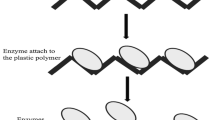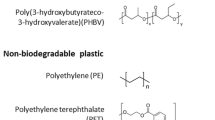Abstract
In this work, the potential effect of metals, such as Cd, Cu and Pb, on the biodegradation of petroleum hydrocarbons in estuarine sediments was investigated under laboratory conditions. Sandy and muddy non-vegetated sediments were collected in the Lima River estuary (NW Portugal) and spiked with crude oil and each of the metals. Spiked sediments were left in the dark under constant shaking for 15 days, after which crude oil biodegradation was evaluated. To estimate microbial abundance, total cell counts were obtained by DAPI staining and microbial community structure was characterized by ARISA. Culturable hydrocarbon degraders were determined using a modified most probable number protocol. Total petroleum hydrocarbons concentrations were analysed by Fourier Transform Infrared Spectroscopy after their extraction by sonication, and metal contents were determined by atomic absorption spectrometry. The results obtained showed that microbial communities had the potential to degrade petroleum hydrocarbons, with a maximum of 32 % degradation obtained for sandy sediments. Both crude oil and metals changed the microbial community structure, being the higher effect observed for Cu. Also, among the studied metals, only Cu displayed measurable deleterious effect on the hydrocarbons degradation process, as shown by a decrease in the hydrocarbon degrading microorganisms abundance and in the hydrocarbon degradation rates. Both degradation potential and metal influence varied with sediment characteristics probably due to differences in contaminant bioavailability, a feature that should be taken into account in developing bioremediation strategies for co-contaminated estuarine sites.






Similar content being viewed by others
References
Alisi C, Musella R, Tasso F, Ubaldi C, Manzo S, Cremisni C, Sprocati NA (2009) Bioremediation of diesel oil in a co-contaminated soil by bioaugmentation with a microbial formula tailored with native strains selected for heavy metals resistance. Sci Total Environ 407:3024–3032
Almeida CMR, Mucha AP, Vasconcelos MTSD (2004) Influence of sea rush Juncus maritimus on metal concentration and speciation in estuarine sediment colonized by the plant. Environ Sci Technol 38:3112–3118
Almeida CMR, Mucha AP, Delgado MFC, Caçador MI, Bordalo AA, Vasconcelos MTSD (2008a) Can PAHs influence Cu accumulation by salt marsh plants? Mar Environ Res 66:311–318
Almeida CMR, Mucha AP, Delgado MFC, Caçador MI, Bordalo AA, Vasconcelos MTSD (2008b) Influence of a salt marsh plant (Halimione portucaloides) on the concentrations and potential mobility of metals in sediments. Sci Total Environ 403:188–195
Almeida CMR, Mucha AP, Vasconcelos MTSD (2011) Role of different salt marsh plants on metal retention in an urban estuary (Lima Estuary, NW Portugal). Estuar Coast Shelf Sci 91:243–249
Amor L, Kennes C, Veiga MC (2001) Kinetics of inhibition in the biodegradation of monoaromatic hydrocarbons in presence of heavy metals. Bioresour Technol 78:181–185
Atlas R (1995) Petroleum biodegradation and oil spill bioremediation. Mar Pollut Bull 31:178–182
Baldrian P, Wiesche CD, Gabriel J (2000) Influence of cadmium and mercury on activities of ligninolytic enzymes and degradation of polycyclic aromatic hydrocarbons by Pleurotus ostreatus in soil influence of cadmium and mercury on activities of ligninolytic enzymes and degradation of polycyclic. Appl Environ Microbiol 66:2471–2478
Barrett JE, Virginia RA, Wall DH, Cary SC, Adams BJ, Hacker AL, Aislabie JM (2006) Co-variation in soil biodiversity and biogeochemistry in Northern and Southern Victoria Land, Antarctica. Antarct Sci 18:535–548
Becker JM, Parkin T, Nakatsu CH, Wilbur JD, Konopka A (2006) Bacterial activity, community structure, and centimeter-scale spatial heterogeneity in contaminated soil. FEMS Microbial Ecol 51:220–231
Braddock JF, Lindstrom JE, Brown EJ (1995) Distribution of hydrocarbon-degrading microorganisms in sediments from Prince William Sound, Alaska, following the Exxon Valdez oil spill. Mar Pollut Bull 30:125–132
Cardinale M, Brusetti L, Quatrini P, Borin S, Puglia AM, Rizzi A, Zanardini E, Sorlini C, Corselli C, Daffonchio D (2004) Comparison of different primer sets for use in automated ribosomal spacer analysis of complex bacterial communities. Appl Environ Microbiol 70:6147–6156
Chapman PM, Wang F (2001) Assessing sediment contamination in estuaries. Environ Toxicol Chem 20:3–22
Clarke KR, Gorley RN (2006) PRIMER v6: user manual. Plymouth Marine Laboratory, Plymouth
Couto MNF, Borges J, Guedes P, Almeida R, Monteiro E, Almeida CM, Basto MCP, Vasconcelos MTSD (2012) An improved method for determination of petroleum hydrocarbons from soil using a simple ultrasonic extraction and Fourier transform infrared spectrophotometry. Pet Sci Technol. doi:10.1080/10916466.2011.587383
Danovaro R, Corinaldesi C, Luna GM, Magagnini M, Manini E, Pusceddu A (2009) Prokaryote diversity and viral production in deep-sea sediments and seamounts. Deep-Sea Res II 56:738–747
Dempster EL, Pryor KV, Francis D, Young JE, Rogers HJ (1999) Rapid DNA extraction from ferns for PCR-based analyses. Biotechniques 27:66–68
El-Deeb B, Altalhi AD (2009) Degradative plasmid and heavy metal resistance plasmid naturally coexist in phenol and cyanide assimilating bacteria. Am J Biochem Biotechnol 5:84–93
Gosh M, Singh SP (2005) A review of phytoremediation of heavy metals and utilization of its byproducts. Appl Ecol Environ Res 3:1–18
Hewson I, Furhman JA (2004) Richness and diversity of bacterioplankton species along an estuarine gradient in Moreton Bay, Australia. Appl Environ Microbiol 70:3425–3433
Hoffman DR, Okon JL, Sandrin TR (2005) Medium composition affects the degree and pattern of cadmium inhibition of naphthalene biodegradation. Chemosphere 59:919–927
Hughes N, Poole K (1991) Metal speciation and microbial growth. J Gen Microbiol 137:725–734
Kachur AV, Koch CJ, Biaglow JE (1998) Mechanism of copper catalyzed oxidation of glutathione. Free Radic Res 28:259–269
Ke L, Yu KSH, Wong YS, Tam NFY (2005) Spatial and vertical distribution of polycyclic aromatic hydrocarbons in mangrove sediments. Sci Total Environ 340:177–187
Ke L, Luo L, Wang P, Luan T, Tam NFY (2010) Effects of metals on biosorption and biodegradation of mixed polycyclic aromatic hydrocarbons by a freshwater green alga Selenastrum capricornatum. Bioresour Technol 101:6950–6961
Kepner RL, Pratt JR (1994) Use of fluorochromes for direct enumeration of total bacteria in environmental samples: past and present. Microbiol Rev 58:603–615
Khan M, Scullion J (2000) Effect of soil on microbial responses to metal contamination. Environ Pollut 110:115–125
Leahy JG, Colwell RR (1990) Microbial degradation of hydrocarbons in the environment. Microbiol Rev 54:305–315
Long ER, MacDonald DD, Smith SL, Calder F (1995) Incidence of adverse biological effects within ranges of chemical concentrations in marine and estuarine sediments. Environ Manag 19:81–97
Lytle JS, Lytle TF (2001) Use of plants for toxicity assessment of estuarine ecosystems. Environ Toxicol Chem 20:68–83
MacNaughton SJ, Stephen JR, Venosa AD, Davis GA, Chang YJ, White DC (1999) Microbial population changes during bioremediation of an experimental oil spill. Appl Environ Microbiol 65:3566–3574
Malik S, Beer M, Megharaj M, Naidu R (2008) The use of molecular techniques to characterize the microbial communities in contaminated soil and water. Environ Int 34:265–276
Muckian LM, Grant RJ, Doyle EM, Clipson NJW (2007) Bacterial community structure in soils contaminated by polycyclic aromatic hydrocarbons. Chemosphere 68:1535–1541
Muckian LM, Grant RJ, Clipson NJW, Doyle EM (2009) Bacterial community dynamics during bioremediation of phenanthrene- and fluoranthene-amended soil. Int Biodeter Biodegrad 63:52–56
Nies DH (1999) Microbial heavy-metal resistance. Appl Microbiol Biotechnol 51:730–750
Olaniran AO, Balgobind A, Pillay B (2011) Quantitative assessment of the toxic effects of heavy metals on 1,2-dichloroethane biodegradation in co-contaminated soil under aerobic condition. Chemosphere 85:839–847
Porter KG, Feig YS (1980) The use of DAPI for identifying and counting aquatic microflora. Limnol Oceanogr 25:943–948
Ranjard L, Poly F, Lata JC, Mougel C, Thioulouse J, Nazaret S (2001) Characterization of bacterial and fungal soil communities by automated ribosomal intergenic spacer analysis fingerprints: biological and methodological variability. Appl Environ Microbiol 67:4479–4487
Ranjard L, Echairi A, Nowak V, Lejon DH, Nouaım R, Chaussod R (2006) Field and microcosm experiments to evaluate the effects of agricultural Cu treatment on the density and genetic structure of microbial communities in two different soils. FEMS Microbiol Ecol 58:303–315
Riis V, Babel W, Pucci OH (2002) Influence of heavy metals on the microbial degradation of diesel fuel. Chemosphere 49:559–568
Roane TM, Josephson KL, Pepper IL (2001) Dual-bioaugmentation strategy to enhance remediation of contaminated soil. Appl Environ Microbiol 67:3208–3215
Roy S, Labelle S, Mehta P, Mihoc A, Fortin N, Masson C, Leblanc R, Châteauneuf G, Sura C, Gallipeau C, Olsen C, Deslisle S, Labrecque M, Greer CW (2005) Phytoremediation of heavy metal and PAH-contaminated brownfield sites. Plant Soil 272:277–290
Said WA, Lewis DL (1991) Quantitative assessment of the effects of metals on microbial-degradation of organic chemicals. Appl Environ Microbiol 57:1498–1503
Sandrin TR, Maier RM (2003) Impact of metals on the biodegradation of organic pollutants. Environ Health Perspect 111:1093–1101
Savazzini F, Longa CMO, Pertot I (2009) Impact of the biocontrol agent Trichoderma atroviride SC1 on soil microbial communities of a vineyard in northern Italy. Soil Biol Biochem 41:1457–1465
Turpeinen R, Kairesalo T, Häggblom MM (2004) Microbial community structure and activity in arsenic-, chromium- and copper-contaminated soils. FEMS Microbiol Ecol 47:39–50
Van Hamme JD, Singh A, Ward OP (2003) Recent advances in petroleum microbiology. Microbiol Mol Rev 67:503–549
Vidali M (2001) Bioremediation. An overview. Pure Appl Chem 73:1163–1172
Wrenn BA, Venosa AD (1996) Selective enumeration of aromatic and aliphatic hydrocarbon degrading bacteria by a most-probable number procedure. Can J Microbiol 42:252–258
Xu J, Yu Y, Wang P, Guo W, Dai S, Sun H (2007) Polycyclic aromatic hydrocarbons in the surface sediments from Yellow River, China. Chemosphere 67:1408–1414
Young LY, Liang W, Shor L, Kosson D, Rockne K, Taghon G (2002) Bioavailability of PAHs to bacteria in estuarine sediment. Soil Sediment Contam 11:488
Zhang J, Cai L, Yuan D, Chen M (2004) Distribution and sources of polynuclear aromatic hydrocarbons in Mangrove surficial sediments of Deep Bay, China. Mar Pollut Bull 49:479–486
Zhang Z, Rengel Z, Meney K, Pantelic L, Tomanovic R (2011) Polynuclear aromatic hydrocarbons (PAHs) mediate cadmium toxicity to an emergent wetland species. J Hazard Mater 189:119–126
Acknowledgments
This work was partially funded by Fundação para a Ciência e Tecnologia (FCT) through project PHYTOBIO (PTDC/MAR/099140/2008) and REEQ/304/QUI/2005 re-equipment project (co-financed QREN and COMPETE via FEDER).
Author information
Authors and Affiliations
Corresponding author
Rights and permissions
About this article
Cite this article
Almeida, R., Mucha, A.P., Teixeira, C. et al. Biodegradation of petroleum hydrocarbons in estuarine sediments: metal influence. Biodegradation 24, 111–123 (2013). https://doi.org/10.1007/s10532-012-9562-9
Received:
Accepted:
Published:
Issue Date:
DOI: https://doi.org/10.1007/s10532-012-9562-9




